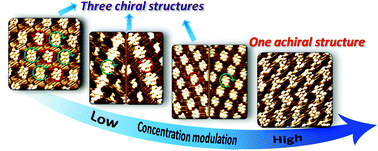Concentration-dependent structure and structural transition from chirality to nonchirality at the liquid–solid interface by coassembly†
Abstract
Understanding the formation and structural transition of the two-dimensional chirality of self-assembly is a subject which still gains significant interest in surface or interface chirality studies. Here, we present the solvent-induced chiral structural transition of a 2-hydroxy-7-pentadecyloxy-9-fluorenone (HPF) molecules’ self-assembled adlayer through coassembly with achiral aliphatic solvents under different concentrations. Polymorphic chiral patterns are obtained at low concentrations of aliphatic solvents with different chain lengths. The HPF molecules form coassembled structures with these solvents through van der Waals interactions. At the same time, at high concentrations, HPF molecules uniformly form a nonchiral multimer structure without coadsorbed aliphatic solvent molecules. What is interesting is that these structures under different concentrations will finally change into a zigzag structure, which is the thermodynamically most stable configuration. Especially when using n-hexadecane as the solvent, the adlayer shows perfect steric matching due to the close chain length of HPF and n-hexadecane, which can maximize the molecule–solvent interactions. Thus, HPF molecules in n-hexadecane exhibit the most diversiform configuration. The distinct concentration-dependence has proven that the solvent molecules can act as a coadsorbed component through van der Waals interactions rather than simply a dispersant and further result in the probability and stability of chiral self-assembled monolayers by subtle tuning of the solvent–molecule and solvent–substrate interactions. This result provides a simple and alternative strategy to construct the 2D chiral assembled monolayer.


 Please wait while we load your content...
Please wait while we load your content...